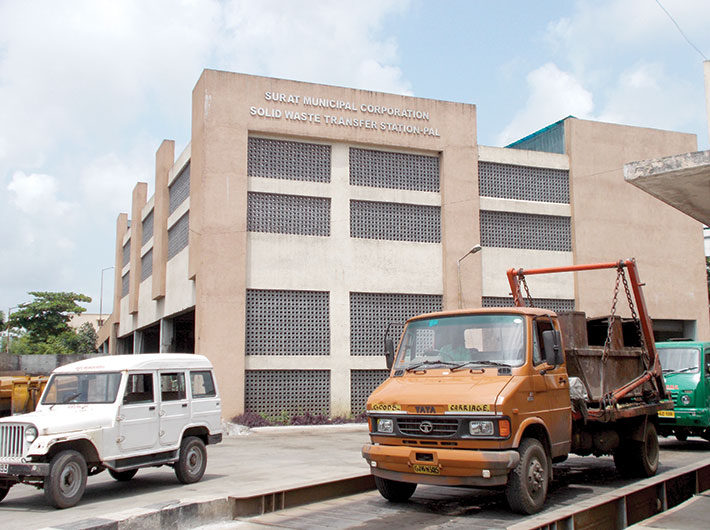Rising out of an epidemic, Surat has made incredible progress in waste management with citizen participation – a model worth emulating
Natwarlal Patel still remembers those few days in 1994 when a plague epidemic broke out in Surat. He spent a week holed up in his home, too afraid to venture out. He and his family managed to feed themselves with whatever was stocked in the kitchen. Though the city was back on its feet within a week, what the Suratis witnessed in those few days would forever change the way they would think about waste – one of the factors behind the epidemic.
Planning step by step
For the Suratis, the plague was a wakeup call. EH Pathan, executive engineer in charge of drainage and solid waste management at the Surat municipal corporation (SMC), explains that before the plague, citizens as well as sweepers used to throw garbage at certain vacant spots where it would keep piling up. These spots used to attract rag pickers and animals. At night garbage was loaded onto trucks and sent away to disposal sites. During the mid-1990s, garbage was disposed of in the low-lying areas on the banks of a creek near the city – a practice that was stopped in 2002.
After the plague, people realised that it was dangerous to dispose garbage in the open in the city. It was around this time that the municipal corporation started exploring options for better waste management.
“We started identifying locations to install containers where citizens and sweepers could dispose of the garbage. A concrete platform was built and containers were installed where people of the residential areas as well as commercial hubs can dispose of their waste,” says Pathan.
Initially there were 1,800 containers in the city, though there are only 1,000 of them today, after the SMC started door-to-door garbage collection in 2001, hiring private contractors who collect waste from residential and commercial areas and dispose it.
Meanwhile, Surat was expanding at an incredible rate – emerging as arguably the fastest growing city in the country. “In 1991, the population of the city was around 13 lakh which rose to 24 lakh by 2001 and further to 46 lakh by 2011. It was not easy for SMC to keep pace with rapid urbanisation but we tried our best,” says Pathan.
Around 2002, SMC got 200 hectares of land for the final disposal of waste.
“We thought of storing the garbage at a temporary location in the city before transporting it to the final disposal site,” says Pathan. Initially the biggest challenge was to find land for the transfer station and the disposal site. “Citizens get agitated when they hear that a waste disposal site will come up in their neighbourhood,” he adds.
In 2001, SMC constructed transfer stations as temporary garbage disposal sites which too became a nuisance. “At the Varachha and Katargam transfer stations waste used to be unloaded on a concrete platform and covered with tarpaulin before shifting it to the disposal site. There was no roof and foul smell from the garbage became a problem. So we decided to make it a modern transfer station,” he says.
“When the modern transfer station was under construction, people used to mistake it as commercial property and approach us for booking purposes,” laughs Pathan.
At the Varachha transfer station in the west zone of the SMC, sanitary inspector BD Banglawala diligently records the weight of the trucks bringing in waste. He explains that door-to-door waste collection has been outsourced to private contractors and depending on the contract they are paid between '650 to '1,250 per metric tonne of waste. Banglawala sits in a cabin at the entrance of the station. The truck stops on a weighing platform in front of his cabin. He records the gross weight before the truck move up a raised platform to dump the waste in a funnel-shaped chute where garbage is compacted into blocks by repeated blows from a piston. As the truck comes down, it stops once more in front of Banglawala’s cabin allowing him to record the “tyre weight”, that is, the net weight minus garbage. The vehicle tracking system monitors the trucks to ensure the vehicles are following the route chalked out for them. Banglawala has a camera to see to it that garbage is not tampered with.
From time to time, Banglawala has to keep jabbing his thumb in a fingerprint identification machine which is wired to the computer to prevent the system from shutting down. This ensures that the system is not tampered with. After compaction, garbage is loaded into containers and sent to the final disposal site.
“The present area of the city is 326 square kilometres and six transfer stations are in operation. Keeping in mind the population growth, we are planning four more transfer stations in the outskirts of the city,” he adds.
Solid waste management now
Surat generates 1,400 metric tonnes of garbage every day. At the final disposal site on the outskirts of the city, a waste treatment plant has been set up where 400 metric tonnes of waste is treated daily to make compost and fuel.
“After an open bidding we had invited a company which had the technology to treat waste. Hanjer Biotech was selected. As there is no segregation of waste at source, so the plant had to come up first,” Pathan says.
At the plant, located in the same complex as the disposal site, which became operational in 2008, the mixed waste is segregated into dry and wet waste. The dry waste is used to make refuse-derived fuel (RDF) and the wet waste is used to make organic manure which is then sold to Krishak Bharati Cooperative Limited (KRIBHCO) and local farmers. As much as 15-20 percent manure and RDF is obtained per day from the waste. Plastic waste is processed into ingots which is raw material for plastic makers and is sold in the market.
Hanjer officials tell Governance Now that mass and volumetric segregation is applied before treating the waste. They admit that the process is tedious for them as segregation is not done at the source.
The waste treatment plant has had its share of troubles. Surat, a textile hub, generates a lot of textile waste. Long cloth pieces would often get jammed and damage the machines. The waste treatment plant had to be modified according to the characteristics of the waste.
Plans are underway to generate electricity out of the 1,000 metric tonnes of the remaining, ‘rejected’ waste.
“Rochem Separation System India Pvt Ltd has been given the tender to develop a waste-to-energy plant. They will set up the plant with their own money and sell the electricity they will generate out of the waste. Rochem will pay us royalty at the rate of '30 per tonne and every year there will be an increment of 5.4%,” says Pathan.
“Once the waste-to-energy plant is set up, the rejected waste will come down to just 200 tonnes,” he adds. The plant is expected to be fully operational by December 2014. The development of the modern transfer station and landfill site was done under the Jawaharlal Nehru national urban renewal mission (JNNURM).
Sewage treatment
At the Anjana sewage treatment plant 85-90 million litres per day (mld) of sewage water is treated per day. Biogas and sludge are separated from the incoming sewage water. Sludge is treated and sold in the market as manure and biogas (methane) is used to generate electricity. Seventy percent of electricity cost is saved as the electricity generated from the biogas is used in treating the sewage water. The treated water is released into the nearby Koyli Khari creek which flows into the Arabian Sea. There are ten such sewage treatment plants in Surat.
People’s participation
To involve citizens in waste management, the SMC has devised an initiative called Anudan. Under the scheme, housing societies are paid 60 paise per square metre as an incentive by the corporation to keep their area and adjoining municipality roads clean.
The Suryapur society in Adajan Patiya, which falls in the west zone of SMC, has adopted the Anudan scheme. The society, home to 149 families, has its own sweeper to keep the premises clean.
Kailash Narayan Borse, sanitary inspector, endorses the Anudan scheme saying that in an ideal situation the public should take responsibility for cleanliness. “The sweepers employed by the municipal corporation are prone to absenteeism. In their absence you have to hire someone and a supervisor is needed to make sure he is doing his work properly,” he says.
Natwarlal Patel, a resident of the society, tells Governance Now that the society has hired its own sweeper to keep the society clean and the road in front of the society clean. He is paid '5,000 monthly. “Municipal sweepers may skip work once in a while. With our own sweeper, we make sure the society is cleaned every day. In case he is absent, he sends a replacement or we deduct his wages for the day. We are in charge of keeping the area clean,” he says.
“We had adopted the Anudan scheme right from its inception in 1998. Before that, there would be days when trash would just collect in the roads,” he adds.
Borse clarifies that it is up to the societies to decide whether they want to adopt the scheme. Around 1,200 societies have so far joined in.
RJ Patel, deputy commissioner, SMC, says civic authorities are in the process of making committees under Swachchhata Sahayog Samiti for every ward. The stakeholders of this committee will be the youth, teachers, NGO and women.
“They will be supporting us in creating awareness about sanitation. Swachchhata Sahayog Samiti will impart training to every society and locality. The corporation officials will impart training to them to bring about more awareness mainly on the need for segregation of waste,” he adds.
Surat has come a long way since 1994. Officials agree that after the plague, authorities – political leaders as well as bureaucrats – have utilised their power and it was easy to bring about change thanks to public awareness. Had there been no plague, it would have taken much longer for the mindset to change. The citizen’s participation has been a major factor in the success of the waste management programmes.
“At the end of the day whatever is being done is for the people. So without the people’s support we cannot succeed,” says RJ Patel.
This story appeared in the March 1-15, 2014 edition of the print edition

